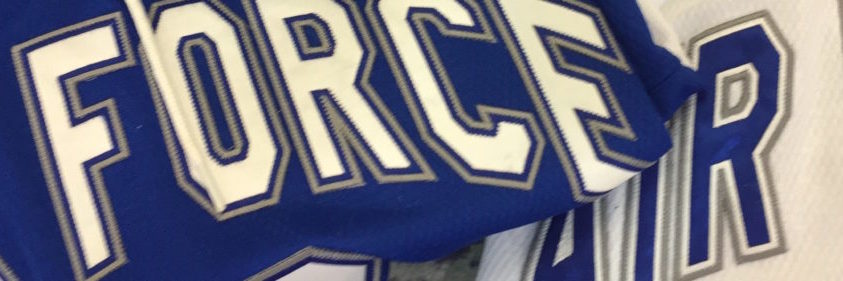Football coach Bill Parcells is fond of saying: You are what your record says you are.
Parcells spent roughly 15 years as a college coach – including at Air Force for one season, in 1978 – before beginning his Pro Football Hall of Fame NFL career. So with that in mind, let’s take a closer look at Air Force’s 12-22-2 season that resulted in it missing the Atlantic Hockey playoffs.
I watched almost every Falcons game in person or online. I went back and watched a couple of them after the season. A few months later it’s difficult to wrap my arms around the fact they won one-third of their games. That’s because this was a team that returned everyone but its starting goaltender and was primed for a deep playoff run.
Three areas Air Force hockey must improve

Air Force goaltender Guy Blessing. Photo courtesy of Paat Kelly / Pengo Sports via Air Force Athletics
1. Air Force must solidify its goaltending
No team in Division I hockey (or maybe anywhere outside of the NHL) started four goaltenders, as the Falcons had to. And they covered just about every reason under the sun in the process.
To recap:
- Freshman Aaron Randazzo started three games due to an injury to sophomore Guy Blessing. He went 0-2-1 with a 5.23 goals-against average and a .824 save percentage. Randazzo left the team early in the season, then left the Academy.
- Blessing played the most games (15), went 6-8-1 with 3.23 and .889 numbers, but he was bitten by the injury bug again and shut down for the second semester.
- Cue junior Maiszon Balboa, who played a career-high 13 games and won the first four games of his career, posting 3.07 and .894 numbers. But, he also dealt with injuries.
- So senior Austin Park ended up playing a career-high 10 games and picking up his first two wins. He was one of the season’s great stories, which is fitting because he’s one of the team’s great guys in a group full of them.
Although the Falcons’ systems are dialed in, there still are nuances with each goalie that his defense (especially) must navigate.
Conclusion: Blessing and Balboa both are capable, and you can bet the Falcons will bring in two more goaltenders in the event lightning strikes twice.
2. The Falcons can’t fall prey to extended slumps
Air Force defeated Bentley, 2-0, on Nov. 12 … and didn’t win again until Jan. 20. A 10-game winless streak and a skid of 12 of 13 games would be too much for many NHL teams playing 82 games to overcome to say nothing of a college team.
One culprit was offense or a lack thereof.
The Falcons scored 36 goals in their first 12 games and were 6-5-1. They had just 15 in the next 10 games and 23 over the 12-of-13 slump. Eight times they scored one goal and they were shut out once.
AFA won five of six to at least get within striking distance before losing 4-1 to Canisius on Valentine’s Day. They closed with four more losses. So if one takes the final five games and the 13-game skid, they went 1-16-1. Win a third of those and you’re at 18 wins and possibly hosting a first-round AHA series.
Another culprit was the bad habit of giving up first goals, which Air Force did in 22 of 36 games. The Falcons went 4-17-1 in those 22 games.
3. Air Force has to win the special teams war
Air Force had long stretches of very good penalty killing, including finishing with a 91.4 percent kill rate over the final 10 games. But some of its worst losses came in discipline meltdowns.
- A 7-6 loss at Lindenwood – three power-play goals against.
- An 8-0 loss at Colorado College – four power-play goals against.
- A 5-1 loss to Bentley – two power-play goals against.
- A 4-1 loss to Holy Cross – two power-play goals against.
You get the idea.

The 2022-23 season was a very un-Air Force-like one in every regard except one. The Falcons battled, the blow-outs were rare. Close followers of the team could count on one hand the number of times two of these three areas combined appeared in one season. All three?
It was too much to overcome.
Follow The Flight Path on Twitter: @AFAFlightPath






